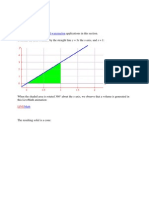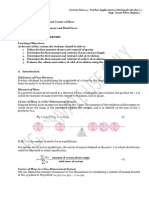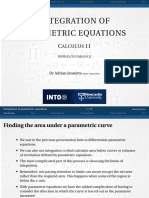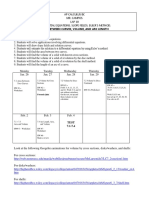Chap 7.3 - Volume of Revolution - Shell Method
Uploaded by
copperheadkiller13Chap 7.3 - Volume of Revolution - Shell Method
Uploaded by
copperheadkiller137.
3 Volume of Revolution – Shell Method
In the last section, we used the Disk Method to find the Volume of Revolution
formed by:
♦ Revolving y = f(x) about the X axis or a horizontal line parallel to the X axis.
♦ Revolving x = f(y) about the Y axis or a vertical line parallel to the Y axis.
In both cases, the Disk is Perpendicular to the Line of Revolution.
If the Disk is Parallel to the Line of Revolution then finding the volume becomes
a complex washer problem.
For example, find the volume of the solid formed by rotating the region between
the function y = 3x – x2 and the X axis about the line x = –1
Fortunately, there is a another method, called Cylindrical Shells, that is easier
to use than the Washer Method when revolving y = f(x) about the Y axis or
when revolving x = f(y) about the X axis.
The Method looks complicated, but is it actually rather simple!
1 Volumes using the Cylindrical Shell Method
If y = f(x) is Continuous and Nonnegative on the X interval [a,b] then the
Volume V of the solid formed by Revolving the region between y = f(x) and
the X interval [a,b] and around the Vertical Line x = L (where L ≤ a) is:
A Method of Cylindrical Shells is used when the Washer Method of Volume
of Revolution will not work because solving the function y = f(x) for the
the volume integral is too complicated or impossible.
B Make sure that the function f(x) is Nonnegative over the interval [a,b]
and make sure that the line L is Outside the interior of the interval [a,b].
C If the Vertical Line x = L is on the right side (L ≥ b) of the region then
replace the radius (x – L) with the radius (L – x).
D If the region is Bounded by Two Functions, above by y = f(x) and below
by y = g(x), then replace the height f(x) by the height (f(x) – g(x)).
E If revolving the region between the function x = f(y) and the Y axis over
the Y interval [c,d] around the Horizontal Line y = L then draw a picture
and modify the Cylindrical Shell volume integral limits, radius, height,
and width correctly.
EXAMPLE 1 Page 466
Use the Method of Cylindrical Shells to find the Volume of the solid
formed by revolving the region bounded by y = x – x2 and the X axis
about the given line:
A Line x = 0 (Y axis)
Construct and Evaluate
B Line x = –2
Construct only
C Line x = 3
Construct only
EXAMPLE A Not in Textbook
Use the Method of Cylindrical Shells to find the Volume of the solid
formed by revolving the region bounded by x = y – y3 and the Y axis
about the given line:
A Line y = 0 (X axis)
Construct and Evaluate
B Line y = 1
Construct only
C Line y = ─1
Construct only
EXAMPLE B Not in Textbook
Use the Method of Cylindrical Shells to find the Volume of the solid
formed by revolving the region bounded by y = 2x – x2 and y = x
about the given line:
A Line x = 0 (Y axis)
Construct and Evaluate
B Line x = 1
Construct only
EXAMPLE 5 Page 469
You might also like
- Chap 7.2 - Volume of Revolution - Disk MethodNo ratings yetChap 7.2 - Volume of Revolution - Disk Method6 pages
- Volumes of Revolution Using Application of Integration: 1. IntrodutionNo ratings yetVolumes of Revolution Using Application of Integration: 1. Introdution11 pages
- Volumes of Solids of Revolution: Differential Equations Precalculus 35No ratings yetVolumes of Solids of Revolution: Differential Equations Precalculus 356 pages
- Calculus Session 2 Volume of Solid RevolutionNo ratings yetCalculus Session 2 Volume of Solid Revolution4 pages
- EXP - 2A - BMAT101P - LO - Reference - Material - I - 03 11 2022No ratings yetEXP - 2A - BMAT101P - LO - Reference - Material - I - 03 11 20222 pages
- FALLSEM2023-24 IMAT101P LO VL2023240106440 2023-09-20 Reference-Material-INo ratings yetFALLSEM2023-24 IMAT101P LO VL2023240106440 2023-09-20 Reference-Material-I2 pages
- FALLSEM2023-24 IMAT101P LO VL2023240106440 2023-09-20 Reference-Material-INo ratings yetFALLSEM2023-24 IMAT101P LO VL2023240106440 2023-09-20 Reference-Material-I2 pages
- BRIONES, JOY ANN_SOLID OF REVOLUTION_INDIVIDUAL_RESEARCHNo ratings yetBRIONES, JOY ANN_SOLID OF REVOLUTION_INDIVIDUAL_RESEARCH7 pages
- Unit 2 PT 10 Are A Surface of RevolutionNo ratings yetUnit 2 PT 10 Are A Surface of Revolution7 pages
- CH - 6) Applications of Definite IntegralsNo ratings yetCH - 6) Applications of Definite Integrals19 pages
- Chap 7.4 - Arc Length and Surface Area of RevolutionNo ratings yetChap 7.4 - Arc Length and Surface Area of Revolution7 pages
- AUC & Differential Equation & Binomial 13thNo ratings yetAUC & Differential Equation & Binomial 13th28 pages
- Volume of Solid of Revolution by IntegrationNo ratings yetVolume of Solid of Revolution by Integration5 pages
- Volumes of Revolution, Integration From A-Level Maths Tutor100% (1)Volumes of Revolution, Integration From A-Level Maths Tutor5 pages
- 5.Evaluation of Volume by Integrals (Solids of Revolution)No ratings yet5.Evaluation of Volume by Integrals (Solids of Revolution)4 pages
- With Soln LECTURE 11 - Solids of Revolution (Part 1 - Disk and Ring Method)No ratings yetWith Soln LECTURE 11 - Solids of Revolution (Part 1 - Disk and Ring Method)17 pages
- Calculus II Volumes: Cory Robinson & Blake Moyer With Advisor Jeremy Becnel, PH.DNo ratings yetCalculus II Volumes: Cory Robinson & Blake Moyer With Advisor Jeremy Becnel, PH.D1 page
- Area Under the Curve - Notes and WorksheetNo ratings yetArea Under the Curve - Notes and Worksheet4 pages
- Volume of A Fuel Tank.: List of Proposed Problems Applied MathematicsNo ratings yetVolume of A Fuel Tank.: List of Proposed Problems Applied Mathematics11 pages
- GCE as Level Integration Volume of RevolutionNo ratings yetGCE as Level Integration Volume of Revolution7 pages
- Volumes by Slicing and Rotation About An AxisNo ratings yetVolumes by Slicing and Rotation About An Axis28 pages
- 4) A Level Further Maths Volume of Revolutions QPNo ratings yet4) A Level Further Maths Volume of Revolutions QP6 pages
- 6.2 Volumes of Revolution: The Disk MethodNo ratings yet6.2 Volumes of Revolution: The Disk Method12 pages
- Ntegration of Parametric Equations: AlculusNo ratings yetNtegration of Parametric Equations: Alculus17 pages
- Ch07 Distributed Forces Centroids and Centers of Gravity 2No ratings yetCh07 Distributed Forces Centroids and Centers of Gravity 257 pages
- Calculus Volume by Integration WorksheetsNo ratings yetCalculus Volume by Integration Worksheets18 pages
- 6.2: Determining Volumes by Slicing: Volume and The Slicing MethodNo ratings yet6.2: Determining Volumes by Slicing: Volume and The Slicing Method18 pages
- Maths 3 Application Powerpoint (Amended)No ratings yetMaths 3 Application Powerpoint (Amended)27 pages
- Volumes of Revolution Using Application of Integration: 1. IntrodutionVolumes of Revolution Using Application of Integration: 1. Introdution
- Volumes of Solids of Revolution: Differential Equations Precalculus 35Volumes of Solids of Revolution: Differential Equations Precalculus 35
- EXP - 2A - BMAT101P - LO - Reference - Material - I - 03 11 2022EXP - 2A - BMAT101P - LO - Reference - Material - I - 03 11 2022
- FALLSEM2023-24 IMAT101P LO VL2023240106440 2023-09-20 Reference-Material-IFALLSEM2023-24 IMAT101P LO VL2023240106440 2023-09-20 Reference-Material-I
- FALLSEM2023-24 IMAT101P LO VL2023240106440 2023-09-20 Reference-Material-IFALLSEM2023-24 IMAT101P LO VL2023240106440 2023-09-20 Reference-Material-I
- BRIONES, JOY ANN_SOLID OF REVOLUTION_INDIVIDUAL_RESEARCHBRIONES, JOY ANN_SOLID OF REVOLUTION_INDIVIDUAL_RESEARCH
- Chap 7.4 - Arc Length and Surface Area of RevolutionChap 7.4 - Arc Length and Surface Area of Revolution
- Volumes of Revolution, Integration From A-Level Maths TutorVolumes of Revolution, Integration From A-Level Maths Tutor
- 5.Evaluation of Volume by Integrals (Solids of Revolution)5.Evaluation of Volume by Integrals (Solids of Revolution)
- With Soln LECTURE 11 - Solids of Revolution (Part 1 - Disk and Ring Method)With Soln LECTURE 11 - Solids of Revolution (Part 1 - Disk and Ring Method)
- Calculus II Volumes: Cory Robinson & Blake Moyer With Advisor Jeremy Becnel, PH.DCalculus II Volumes: Cory Robinson & Blake Moyer With Advisor Jeremy Becnel, PH.D
- Volume of A Fuel Tank.: List of Proposed Problems Applied MathematicsVolume of A Fuel Tank.: List of Proposed Problems Applied Mathematics
- Transformation of Axes (Geometry) Mathematics Question BankFrom EverandTransformation of Axes (Geometry) Mathematics Question Bank
- Ch07 Distributed Forces Centroids and Centers of Gravity 2Ch07 Distributed Forces Centroids and Centers of Gravity 2
- 6.2: Determining Volumes by Slicing: Volume and The Slicing Method6.2: Determining Volumes by Slicing: Volume and The Slicing Method






















































































